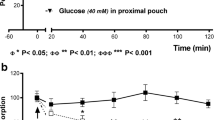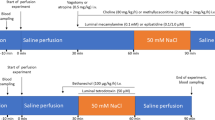Summary
Previous studies showed that nitric oxide (NO), synthesized froml-arginine (l-arg) by NO synthase (NOS) in vascular epithelium and nerve terminals, affects exocrine pancreatic secretion, but its role in control of endocrine pancreas has not been studied. In this study, the role of NO in the control of pancreatic secretion in response to vagal-cholinergic stimulation and duodenal infusion of nutrients was determined in conscious dogs with chronic pancreatic fistulas. Sham feeding (SF), urecholine iv infusion, and duodenal perfusion with nutrients were used to stimulate the pancreatic protein secretion, and insulin and glucagon release in tests without and with iv infusion ofN G-nitro-l-arginine (l-NNA), an inhibitor of NO synthase,l-arg, a substrate of NOS, or their combination was used. SF, urecholine, and duodenal nutrient resulted in the stimulation of pancreatic protein secretion reaching, respectively, 50, 20, and 42% of cerulein maximum. Infusion ofl-arg almost doubled the basal protein secretion and tended to increase the secretory response to SF and duodenal nutrient. After infusion ofl-NNA, the pancreatic secretory responses to SF, urecholine, and duodenal nutrient were inhibited by about 70, 30, and 75%, respectively. Whenl-arg was combined withl-NNA, the reduction in pancreatic secretion byl-NNA was significantly attenuated. SF resulted in a significant rise in plasma insulin and glucagon, and this response was completely abolished byl-NNA infusion. Urecholine and duodenal nutrient also resulted in a marked increment in plasma insulin and glucagon, the insulin (but not glucagon) increment being abolished by the pretreatment withl-NNA and reversed by the addition ofl-arg. We conclude that SF, urecholine, or duodenal nutrient stimulates exocrine and endocrine pancreatic secretion, and that these effects are mediated via the arginine-NO pathway.
Similar content being viewed by others
References
Singer MW. Neurohormonal control of pancreatic enzyme secretion in animals, inThe Exocrine Pancreas: Biology, Pathobiology, and Diseases, Go VLW, ed., Raven, New York, 1993; pp. 425–448.
Sha L, Miller SM, Szurszewski JH. Nitric oxide is a possible neurotransmitter in cat pancreatic ganglia.Gastroenterology 1993; 104: A336.
Vincent SR. Nitric oxide and arginine-evoked insulin secretion (letter).Science 1992; 258: 1376–1378.
Shimosegawa T, Abe T, Satoh A, Asakura T, Yoshida K, Koizumi M, Toyota T. Histochemical demonstration of NADPH-diaphorase activity, a marker for nitric oxide synthase, in neurons of the rat pancreas.Neurosci Lett 1992; 148: 67–70.
Shimosegawa T, Abe T, Satoh A, Abe R, Kikuchi Y, Koizumi M, Toyota T. NADPH-diaphorase activity in neurons of the mammalian pancreas: coexpression with vasoactive intestinal polypeptide.Gastroenterology 1993; 105: 999–1008.
Stark ME, Szurszewski JH. Role of nitric oxide in gastro-intestinal and hepatic function and disease.Gastroenterology 1992; 103: 1928–1949.
Moncada S. Nitric oxide gas: mediator, modulator, and pathophysiologic entity.J Lab Clin Med 1992; 120: 187–191.
Moore PK, Al Swayeh OA, Chong NW, Evans RA, Gibson A.l-NG-nitro arginine (l-NOARG), a novel,l-arginine-reversible inhibitor of endothelium-dependent vasodilatation in vitro.Br J Pharmacol 1990; 99: 408–412.
Rees DD, Palmer RMJ, Hodson HF, Moncada S. A specific inhibitor of nitric oxide formation froml-arginine attenuates endothelium-dependent relaxation.Br J Pharmacol 1989; 96: 418–425.
Konturek SJ, Bilski J, Konturek PK, Cieszkowski M, Pawlik W. Role of endogenous nitric oxide in the control of canine pancreatic secretion and blood flow.Gastroenterology 1993; 104: 896–902.
Konturek SJ, Szlachcic A, Dembinski A, Warzecha Z, Jaworek J, Stachura J. Nitric oxide in pancreatic secretion and hormone-induced pancreatitis in rats.Int J Pancreatol 1994; 15: 19–28.
Holst JJ, Rasmussen TN, Schmidt P. Role of nitric oxide in neurally induced pancreatic exocrine secretion in pigs.Am J Physiol 1994; 266: G206-G213.
Konturek SJ, Pawlik W, Czarnobilski K, Gustaw P, Jaworek J, Beck G, Jendralla H. Effects of leukotriene C4 on pancreatic secretion and circulation in dogs.Am J Physiol 1988; 254: G849-G855.
Thomas JE. An improved cannula for gastric and intestinal fistulas.Proc Soc Exp Biol Med 1941; 46: 260,261.
Konturek SJ, Bielanski W, Solomon TE. Effects of antral mucosectomy, L-364, 718 and atropine on cephalic phase of gastric and pancreatic secretion in dogs.Gastroenterology 1990; 98: 47–55.
Williams JA, Zule DI. Stimulus-secretion coupling in pancreatic acinar cells, inThe Pancreas. Biology, Pathobiology, and Disease, Go VLW, DiMagno EP, Gardner JD, Lebenthal E, Reber HA, Scheele GA, eds., Raven, New York, 1993; pp. 167–189.
Muallem S. Calcium transport pathways of pancreatic acinar cells.Ann Rev Physiol 1989; 51: 83–105.
Pandol SJ, Schoeffield-Payne MS. Cyclic GMP mediates the agonist-stimulated increase in plasma calcium entry in the pancreatic acinar cell.J Biol Chem 1990; 265: 12,846–12,853.
Gukovskaja A, Pandol S. Nitric oxide production regulates cGMP formation and calcium influx in pancreatic acinar cells.Am J Physiol 1994; 266: G350-G356.
Xu X, Star RA, Tortorici G, Muallem S. Depletion of intracellular Ca2+ stores activates nitric-oxide synthase to generate cGMP and regulate Ca2+ influx.J Biol Chem 1994; 269: 12,645–12,653.
Korc M. Normal function of the endocrine pancreas, inThe Pancreas. Biology, Pathobiology, and Disease, Go VLW, DiMagno EP, Gardner JD, Lebenthal E, Reber HA, Scheele GA, eds., Raven, New York, 1993; pp. 751–759.
Schmidt HH, Warner TD, Ishii K, Sheng H, Murad F. Insulin secretion from pancreatic B cells caused byl-Arginine-derived nitrogen oxides.Science 1992; 255: 721–723.
Corbett JA, Wang JL, Misko TP, Zhao W, Hickey WF, McDaniel ML. Nitric oxide mediates IL-1 beta-induced islet dysfunction and destruction: prevention by dexamethasone.Autoimmunity 1993; 15: 145–153.
Laychock SG, Modica ME, Cavanaugh T.l-arginine stimulates cyclic guanosine 3′,5′-monophoshate formation in rats islets of Langerhans and RINm5F insulinoma cells: evidence for L-arginine nitric oxide synthase.Endocrinology, 1991; 129: 3043–3052.
Shimoda I, Ishizuka J, Sato K, Tsuchiya T, Townsend CM, Thompson JC. Mechanism ofl-Arginine-induced insulin release from rat pancreas.Regul Pept 1992; 40: A250.
Corbett JA, McDaniel ML. Does nitric oxide mediate autoimmune destruction of beta-cells? Possible therapeutic interventions in IDDM.Diabetes 1992; 41: 897–903.
Corbett JA, Sweetland MA, Wang JL, Lancaster JRJ, McDaniel ML. Nitric oxide mediates cytokine-induced inhibition of insulin secretion by human islets of Langerhans.Proc Natl Acad Sci USA 1993; 90: 1731–1735.
Delaney CA, Green MH, Lowe JE, Green IC. Endogenous nitric oxide induced by interleukin-1 beta in rat islets of Langerhans and HIT-T15 cells causes significant DNA damage as measured by the “comet” assay.FEBS Lett 1993; 333: 291–295.
Fehsel K, Jalowy A, Qi S, Burkart V, Hartmann B, Kolb H. Islet cell DNA is a target of inflammatory attack by nitric oxide.Diabetes 1993; 42: 496–500.
Kolb H, Kolb Bachofen V. Type 1 (insulin-dependent) diabetes mellitus and nitric oxide.Diabetologia 1992; 35: 796,797.
Burkart V, Kolb H. Protection of islet cells from inflammatory cell death in vitro.Clin Exp Immunol 1993; 93: 273–278.
Author information
Authors and Affiliations
Rights and permissions
About this article
Cite this article
Bilski, J., Konturek, J.W., Konturek, S.J. et al. The involvement of endogenous nitric oxide in vagal-cholinergic stimulation of exocrine and endocrine pancreas in dogs. Int J Pancreatol 18, 41–49 (1995). https://doi.org/10.1007/BF02825420
Received:
Accepted:
Issue Date:
DOI: https://doi.org/10.1007/BF02825420




